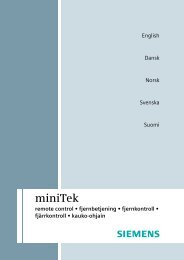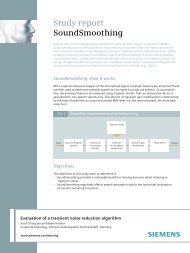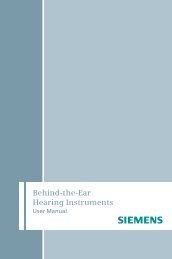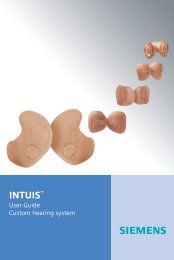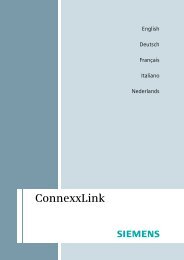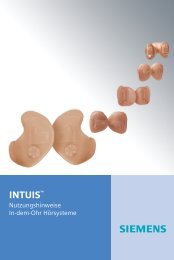CENTRA Active: A new receiver-in-canal solution designed to ...
CENTRA Active: A new receiver-in-canal solution designed to ...
CENTRA Active: A new receiver-in-canal solution designed to ...
You also want an ePaper? Increase the reach of your titles
YUMPU automatically turns print PDFs into web optimized ePapers that Google loves.
V<br />
Research results<br />
VI<br />
Fitt<strong>in</strong>g<br />
guidel<strong>in</strong>es<br />
6<br />
Open loop ga<strong>in</strong> (OLG) measurement<br />
To understand the OLG technique, refer back <strong>to</strong><br />
Figure 2. This illustration shows that the sound<br />
travels through the hear<strong>in</strong>g aid <strong>to</strong> the <strong>receiver</strong><br />
and after it is delivered <strong>in</strong> the ear <strong>canal</strong>, a portion<br />
of the sound leaks back <strong>to</strong> the microphone<br />
and is picked up aga<strong>in</strong>. It is possible, therefore<br />
<strong>to</strong> th<strong>in</strong>k of sound as a “closed loop” (from microphone<br />
<strong>to</strong> microphone) for all types of hear<strong>in</strong>g<br />
<strong>in</strong>struments. When the OLG test<strong>in</strong>g is con-<br />
ducted, however, the hear<strong>in</strong>g aid signal process<strong>in</strong>g<br />
path is split between microphone and<br />
<strong>receiver</strong>. That is, the microphone signal is not<br />
forwarded <strong>to</strong> the <strong>receiver</strong>. Hence, the loop<br />
is opened, which is why it’s referred <strong>to</strong> as an<br />
“open loop” measure.<br />
Now imag<strong>in</strong>e what happens <strong>in</strong> the “closed loop”<br />
if there is no attenuation of the sound that<br />
leaves the <strong>receiver</strong>. As soon as any amount of<br />
ga<strong>in</strong> is applied, the sound will be amplified by<br />
this amount <strong>in</strong> each run through the closed<br />
loop. Because of the speed of sound, this cont<strong>in</strong>uous<br />
loop<strong>in</strong>g effect quickly drives the ga<strong>in</strong><br />
<strong>to</strong> the maximum output of the hear<strong>in</strong>g <strong>in</strong>strument.<br />
If there is a dom<strong>in</strong>ant frequency, there<br />
will be a whistle, or what has come <strong>to</strong> be<br />
known as feedback.<br />
Given this knowledge of the physics of sound,<br />
it becomes clear that the amount of attenuation<br />
<strong>in</strong> the feedback path directly <strong>in</strong>dicates how<br />
much ga<strong>in</strong> can be applied without feedback.<br />
Hence, if we simply measure the attenuation<br />
between the ear <strong>canal</strong> SPL and the microphone,<br />
we know the maximum stable ga<strong>in</strong>; this <strong>in</strong> fact<br />
is the OLG measurement. For example, if a <strong>to</strong>ne<br />
was generated with a known output of 80 dB<br />
SPL, and the microphone picks up this <strong>to</strong>ne via<br />
the feedback path and measures its level <strong>to</strong> be<br />
10 dB SPL, then, the maximum stable ga<strong>in</strong><br />
would be 70 dB at this frequency. It’s important<br />
<strong>to</strong> understand that this value is unrelated <strong>to</strong> the<br />
maximum ga<strong>in</strong> provided by the hear<strong>in</strong>g aid<br />
used <strong>to</strong> conduct the measurement. It simply <strong>in</strong>dicates<br />
the maximum stable ga<strong>in</strong> that potentially<br />
could be delivered, given the ear acoustics,<br />
earmold plumb<strong>in</strong>g and the microphone<br />
location of that particular fitt<strong>in</strong>g.<br />
These record<strong>in</strong>gs were then played back-<strong>to</strong>-back <strong>to</strong><br />
the participants us<strong>in</strong>g a paired-comparison paradigm.<br />
By us<strong>in</strong>g record<strong>in</strong>gs, the participants were bl<strong>in</strong>ded <strong>to</strong><br />
the products themselves, and fac<strong>to</strong>rs such as size of<br />
the hear<strong>in</strong>g <strong>in</strong>strument, comfort of the fitt<strong>in</strong>g, etc.,<br />
were not confound<strong>in</strong>g variables. In each round, all<br />
products were compared <strong>to</strong> each other, and <strong>in</strong> each<br />
comparison, the participant was <strong>in</strong>structed <strong>to</strong> pick<br />
a “w<strong>in</strong>ner” (the hear<strong>in</strong>g <strong>in</strong>strument that they would<br />
prefer <strong>to</strong> use). In the case that two <strong>in</strong>struments<br />
sounded the same, the subject was <strong>to</strong> <strong>in</strong>dicate that<br />
as well. The complete round-rob<strong>in</strong> procedure was<br />
repeated two times, result<strong>in</strong>g <strong>in</strong> a <strong>to</strong>tal of 18 comparisons<br />
for each hear<strong>in</strong>g <strong>in</strong>strument.<br />
Fig. 7 Preference <strong>in</strong> direct comparison<br />
W<strong>in</strong>s / %<br />
50<br />
40<br />
30<br />
20<br />
10<br />
0<br />
Figure 7: Percent of w<strong>in</strong>s <strong>in</strong> paired comparison test for three<br />
different listen<strong>in</strong>g conditions. Data represents pair<strong>in</strong>gs where<br />
differences were noted.<br />
The results of this research are illustrated <strong>in</strong> Figure 7.<br />
Shown are the percent of w<strong>in</strong>s for each product for<br />
each listen<strong>in</strong>g condition. As all devices were premium<br />
products, <strong>in</strong> several of the comparisons, no difference<br />
could be detected. However, observe that<br />
when differences were noted, <strong>CENTRA</strong> <strong>Active</strong> consistently<br />
had the most w<strong>in</strong>s for all three listen<strong>in</strong>g conditions.<br />
These f<strong>in</strong>d<strong>in</strong>gs reveal that even when compared<br />
<strong>to</strong> the highest level of competition, the signal<br />
process<strong>in</strong>g and acoustics of <strong>CENTRA</strong> <strong>Active</strong> have a<br />
dist<strong>in</strong>ct advantage.<br />
Fitt<strong>in</strong>g guidel<strong>in</strong>es<br />
In general, fitt<strong>in</strong>g decisions and procedures concern<strong>in</strong>g<br />
<strong>CENTRA</strong> <strong>Active</strong> are similar <strong>to</strong> other members of<br />
the <strong>CENTRA</strong> family. There are some specific issues <strong>to</strong><br />
consider for <strong>CENTRA</strong> <strong>Active</strong>, however, that will be<br />
discussed <strong>in</strong> this section.<br />
Fitt<strong>in</strong>g range<br />
<strong>CENTRA</strong><br />
<strong>Active</strong><br />
HI #2<br />
Speech <strong>in</strong> noise<br />
Speech <strong>in</strong> quiet<br />
Music<br />
HI #3<br />
HI #4<br />
As shown <strong>in</strong> Figure 8, <strong>CENTRA</strong> <strong>Active</strong> is appropriate<br />
for a wide range of hear<strong>in</strong>g losses. In observ<strong>in</strong>g the<br />
fitt<strong>in</strong>g range, it’s important <strong>to</strong> consider that the upper<br />
limit of the fitt<strong>in</strong>g range for Siemens hear<strong>in</strong>g






